
Faro – Villa Real de Santo Antonio (Portugal) – Ayamonte – Jerez – Cádiz (Spain) – Gibraltar (Britain) – Malaga – Almería – Alicante (Spain)
784 km cycled
This winter trip was Kurt’s idea to check out possible retirement base camps. A string of towns on the Iberian south coast and a little hinterland combined with sunshine and blue skies sounded enticing, even without a purpose attached.
We flew to Faro because of the airport’s proximity to Andalucia. The airport caters well to cyclists with an assembly area fully equipped with a bike stand and pump at every over-sized baggage door.

After a spin to the low-key beach on Faro Island, via the Ria Formosa Natural Park, we rode into town for an explore. Cobblestone streets, white-washed houses and trees laden down with oranges are a whole lot more aesthetically pleasing than the monochromatic snowy rooftops and naked branches back home.




The cathedral is built on the site of a former mosque, and boasts amazingly ornate side altars with azulejos and gilded wood carvings, while the bone chapel outside has the gleaming white bones of over 1,000 monks’ skeletons as decoration!


The coast from Faro to Huelva in Spain has a load of sandbanks and islands, so the road goes inland through citrus plantations, with the occasional village thrown in for good measure. It was quite serene cycling.


Tavira’s old town with 30 churches and a Moorish castle was a lovely little surprise en route and well worth a visit. The quiet roads continued past salt mines and shrubbery to the border.




Villa Real de Santo Antonio was our last stop in Portugal and maybe we should have spent the night there instead of taking the last river ferry of the day over to Ayamonte. The owners of hotels and guesthouses all seemed to have skipped town; we circled the centre and the surrounding hills a few times before we finally found a bed for the night. Finding food was a whole lot easier, and the next morning we even located a wonderful via verde cycle route out. It was a pleasant ride through the tidal mudflats with storks and spoonbills in every puddle.


By lunchtime, we had reached the town of Lepe. Darina was beside herself with excitement (and curiosity) as the poor locals are the butt of most jokes told in Spain. They go something like this:
Two lads from Lepe meet on the road. One is carrying a sack over his shoulder.
-What do you have in the sack?
-Chickens!
-If I guess how many chickens you are carrying, can I have one?
-If you guess correctly, you can have both of them.
-OK, let me see, … five?
Well, contrary to the backward village and villagers depicted in many of the jokes, what we encountered was a buzzing town full of cafes and terraces, and a waiter who was capable of thinking twice so he only had to walk once!

As it happens, the local Josés are not that stupid at all. In recent years, Lepe has become one of the wealthiest towns in the area thanks to their clever idea to bombard central Europe with locally-grown strawberries, while the northern variety lie in hibernation under a blanket of snow.


After our failed attempt two years ago, the Doñana National Park beach was on the cards again. Alas, it was not to be! Low tide was at 7am and 7pm, both firmly in the dark hours of the day. This resulted in a day’s detour via Coria del Río, a few km south of Seville, where we took the ferry across the River Guadalquivir.

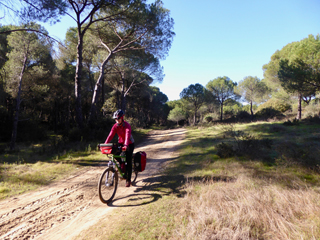
From there we had a full day of cycling in a plain of rice fields, cotton plantations and irrigation canals. It was mid-afternoon until we spotted a bit of topography again, rolling over a few low hills into Jerez de la Frontera, which was our first Spanish highlight of the trip.




This beautiful town gained wealth over the centuries thanks to sherry wines and pure-bred horses. We spent a few wonderful hours visiting the Fundador cellars, learning about the production process and the successful Irish Terry family that moved to Andalucia from Cork, having had their estate confiscated by Cromwell, the English Lord Protector, in the late 17thcentury. They had a pretty decent life there trading wines and breeding Cartujano horses, while their fellow countrymen and women were inflicted with the Penal Laws and near-genocidal Cromwellian rule back home.


That same evening the Three Wise Men came to town, with a lot of floats, dancers, advertisers, presents and 23 tons of candy for the kids from 0-80 years of age! You can’t imagine the sticky mess that incurred as the overlooked sweets were trodden into the streets and pavements.

The next day we had a click-pedal experience because of all the residual sugar on the soles of our shoes!!!

El Puerto de Santa María was another pleasant surprise, complete with bull ring, castle, beach and a boat over to Cádiz.
Cádiz. Now that is definitely a place where we could live happily ever after. Besides its few kilometres of beach, it boasts pleasant promenades along the fortifications, an old town full of little plazas, and beautiful houses finished off with towers of varying shapes and sizes (a traders’ game of “mine is bigger than yours”).




The CA 33 out of town was a stress-free dual carriageway all the way to San Fernando. It was only after we reached Chiclana de la Frontera that our trip became a coastal one.

With beaches on the right, pine forests on the left and the odd lighthouse here and there, this delightful route led us to the Roman ruins of Baelo Claudia in Bolonia.



It was news to us that the Romans built factories in the area to produce garum, a fish sauce made from fermented fish innards and other remnants. Cádiz was famous for this too. Such smelly factories are not exactly what you would expect to find beside grand Roman settlements complete with amphitheaters and temples. For a bit of culture and garum, have a look at Asterix and the Chariot Race here.


Our next stop was Tarifa, the southernmost point of mainland Europe. It came complete with fabulous views of Morocco, just across the narrow Strait of Gibraltar. Tarifa’s walled white-washed old town is full of hostels and restaurants hoping to cash in on the wind and kite-surfer crowd that congregates in the area because of the 330 days of wind/year. Well, the surfers stay economically in their camper vans out at the beach, and frequent the supermarket, rather than gracing the local businesses with their presence. It looks like a bit of market research wouldn’t have been a wasted effort. Cute as it is, since we’re not surfers, Tarifa would be far too windy for a basecamp. Either getting out or getting back would have us curse even the most beautiful home.


On the main road to Algeciras, the traffic was non-existent, and the hills were gentle. Algeciras has a surprisingly pleasant center, but from there we had to face the dual carriageway to La Línea de la Concepción. The ride was not too bad considering the traffic and the road. And when we did wander off at the wrong exit, a bicycle sign brought us back on track through a gap in the fence! We passed another Carthaginian / Roman ruin where even more garum was produced, but nowadays the smells are definitely more refinery related. Smoky chimneys and gas storage tanks were the backdrop until the massive rock of Gibraltar came into view.
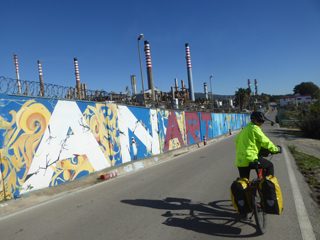

La Línea de la Frontera would be a more apt name for La Línea de la Concepción because of its international border with Gibraltar, a British crown colony since 1713.

We stayed in La Línea for a third of the price of Gibraltar, and a tour of the town quickly revealed its working-class nature with endless tower blocks to accommodate the thousands of blue-collar Spanish workers who earn their pounds across on this peculiar British rock.
It’s just a short walk across the airport’s runway to this British Overseas Territory, where English is spoken. At the border we were told to stick to the right-hand side of the road, just like in Spain.
This is the only accessible British territory where the traffic is on the right, and it’s a clever accident-prevention decision considering you are in and out on a bike in just a few hours. We cycled through town to Europe Point at the southern end which is dominated by an impressive mosque and a lighthouse.

The locals recommended the cable car to the top of the Rock to avoid the many minibuses who ply their trade on the narrow roads up. We had hardly left the cable car cabin when a monkey jumped right onto Kurt’s head in search of edibles. Another strong argument for wearing a helmet!
You might wonder about the presence of monkeys in Europe. Well, it is thought that these Barbary Macaques came originally from Morocco and, according to legend, the Rock will remain in British hands as long as there are monkeys on it. What an analogy! Actually, when the monkey numbers dropped to a mere seven after World War II, Churchill didn’t hesitate in having the population restocked – to be sure, to be sure!
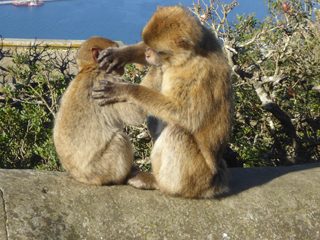

After a stroll on the ridge, Darina went a bit further to explore the caves that were built during the Great Siege that started in 1779, when the Spanish declared war on Great Britain. Meagre provisions and widespread scurvy on the Rock were not enough to force the Brits into submission, and numerous convoys from England managed to break the Spanish/French blockade, bringing supplies and ammunition for those stranded on the Rock. The monkeys were even instrumental in warning the Brits of a surprise nighttime attack. After three years, seven months and twelve days the Spanish and French troops retreated with a massive death toll, and the Rock was to remain British territory. This is incidentally the only one of the fourteen British Overseas Territories that is part of the EU. At least, for the moment!

With Brexit looming just weeks away, it was fascinating to talk to the locals about how they see their future post-Brexit. While 97% of Gibraltarians voted to stay in the EU, now, two years on, those we spoke to were very angry with the EU proposal to give joint sovereignty to Spain and Britain. Many are now fully in favour of Brexit, with or without a deal. Spain has been known to close the border before, but with Morocco a mere 17-minute flight away, the residents feel confident they wouldn’t be short of supplies. Of course, for the Spanish from La Línea walking across the border on a daily basis, and dependent on those hard-earned pounds, it’s a different story. This is going to be an interesting chapter.
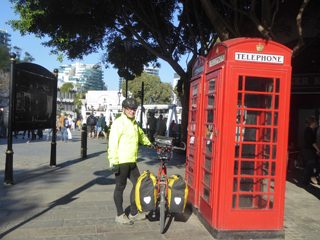

Main street is like any High St in the UK with Marks & Spencer’s, Next, red letterboxes and phoneboxes reminding you that you are no longer in Spain. Darina enjoyed a 99-ice-cream cone in the main square as an Aussie left the next terrace ranting about how the lunch bill had cleaned him entirely. Prices are about double of what you would pay in Spain, just a short walk away.
Kurt took it easy, totally depleted by a nasty cold and a cough comparable to someone who had worked in a mine for over 50 years! His cold and the prospect of a huge detour due to a bicycle ban on the coastal dual carriageway prompted us to take a bus to Malaga. Our tranz-bags came in handy because bikes need to be packed for public transport in Spain. From what we saw outside the bus window, we didn’t miss much. The whole stretch past Estepona, Marbella and Torremolinos is very built up right back to the third row of hills in from the coast. Definitely not a retirement prospect!

Malaga was a pleasant surprise. We had fond memories from an earlier visit but since then the harbour area has been upgraded and is a lovely spot for a stroll. The town was buzzing with really good buskers on every corner, and while the sales were on, there were not too many tourists among the milling crowds.


A hike up to the Castello Gibralfaro offers magnificent views over town – and below, opposite the Picasso museum, a little Louvre-like glass pyramid covers, you guessed it: a former Roman garum factory!


From there we had the best three days of coastal cycling on this trip. Bicycle lanes, bicycle routes and quiet roads led us all the way to Almería with delightful whitewashed towns like Nerja and Salobreña on the way.



Plastic tunnels on the hills were reminiscent of rice terraces, but they could work a little on the colour of the plastic! One thing we didn’t expect was the exorbitant numbers of medieval defensive structures from towers to castles, all to keep Brits and other pirates out 😉



In Adra, having searched in vain for accommodation, we pulled up outside the yacht club to consult www.booking.com. That’s when we were approached by Paddy enquiring about the possibility of cycling from there to the UK. He swung us a few stories about his round-the-world yacht trips before inviting us onto his self-built yacht for a cup of tea, and insisting we spend the night on this well-travelled vessel. Back up the hill in their delightful home, his wife Diana stopped her poetry writing to give us a wonderfully warm welcome.

The evening continued in the marina restaurant as we heard about their fascinating life bringing up two kids on board, building guitars and getting jobs for the time they were ashore. We could have spent the whole holiday just listening to their adventurous, entertaining stories.
After Adra, plastic tunnels were the name of the game. As far as you could see, the landscape was a sea of white (peppers for the world), and by the time we arrived in Almería we were happy to see houses and a landscape too arid even for tunnels. It was here that Darina took to the bed with Kurt’s bug.


She didn’t miss much; Almería is not really the life and soul of a party. Come to think of it, it’s even a bit dull for a funeral!
With the new cold, we ended up behind time and decided to leave the coastal stretch to Alicante for another trip.
A bus brought us there in four hours and we had two days to relax and enjoy a lively town with a castle, beaches and a market to take our taste buds for a ride. What a positive ending to a lovely trip, while the snow was piling up at home!,




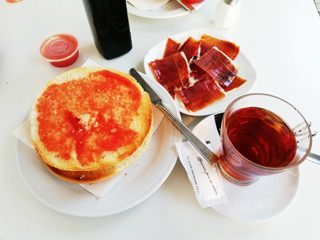
We ate like kings on this trip, although breakfasts did become a little predictable. Tostadas could be varied with jams, honey, chorizo, ham or sobrasada… but they were still tostadas!
For lunch, we generally opted for a picnic, sandwich or tapas (small dishes often served free with drinks) on the road. Speaking of drinks: Kurt thought that some of the beer sizes were a little too compliant with AA requirements 😉
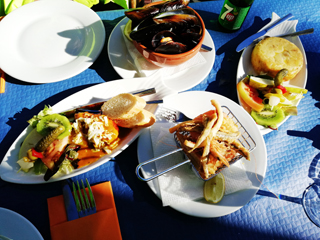







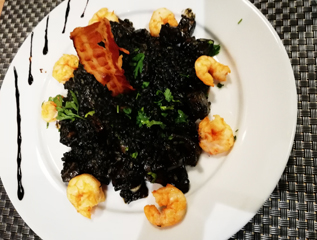

Dinner was always a treat, and portions were more than generous. What we enjoyed most were the rice dishes like paella, barbequed meat and seafood. We rarely had place for dessert!
There was no shortage of accommodation, and we paid between 30 and 60€/night in apartments, pensiones or hotels. Breakfast was an optional extra in the hotels, and rarely available in the pensiones.


Andalucía caters well to cyclists. Most towns have bike lanes and there are countless via verde dirt trails criss-crossing this wonderful autonomous community. Drivers are courteous, and cycling in this region is heaven.
And what about Kurt’s base-camp idea?
Well, he’s none the wiser! While Jerez, Cádiz and Malaga stood out as agreeable cities, evening temperatures were too cold for comfort. There were even a few towns with an ice rink in the central plaza! So, for the time being, Kurt’s content to wait for other inspirational possibilities. They make for good holidays if nothing else!



